/cdn.vox-cdn.com/uploads/chorus_image/image/60792621/1009963290.jpg.0.jpg)
I’ve been doing this series since January (Pedro Martinez at the ’99 All-Star Game was the first). Every week. Lots of fun breakdowns and all manner of pitching nerdery, and yet somehow I have never covered Clayton Kershaw. You know, three-time Cy Young winner. MVP. Definite Hall of Famer.
Never covered. Sigh. It’s a stain on my career.
That ends today.
I can remember a young Kersh tantalizing prospect watchers way back when, and boy oh boy did he ever deliver on that promise. Kershaw’s peak is basically otherworldly. You’d feel weird having this kind of run in MLB: The Show. (Are my sliders out of whack? Am I accidentally playing on Easy?).
Check this. From 2011-14, Kershaw threw 895 innings to a 2.11 ERA. He struck out 948 and walked just 200. That’s … wow. That’s unreal. Tons of punchouts, barely any walks, incredible ERA over nearly 900 innings thrown. That’s an all-time peak. Promise delivered.
And the thing with Kershaw is, he’s a painter. Kershaw had ridiculous stuff, but he wasn’t a Roger Clemens or Max Scherzer type, beating you into submission with high velocities. Kershaw could dial up the heat, no doubt, but he dominated more with pinpoint control and breathtaking movement. Kershaw at his peak was a marvel. His curveball, in particular, was a work of art.
Age never loses, and Kershaw isn’t the pitcher he once was, but dude, that’s a long slope down to the bottom. He’s still great; 117 innings, 146 ERA+ in 2019. Heavy is the head that wears the crown. Let’s take a look at his recent work in the third inning against the Washington Nationals.
Kershaw works comfortably to both sides of the plate
Kershaw starts things off with a four-seamer to Victor Robles. I’ve always been fascinated by the lanky lefty’s delivery. I can’t believe Kershaw has thrown this way for so long without tons of prolonged slumps. How in the world does he not lose his release point over and over?
The thing is, it cannot be easy to pick up the ball against him either. That’s a huge — and often unappreciated — part of the game. Plus, the way Kershaw raises both arms over his head allows him ample opportunity to screw with timing.
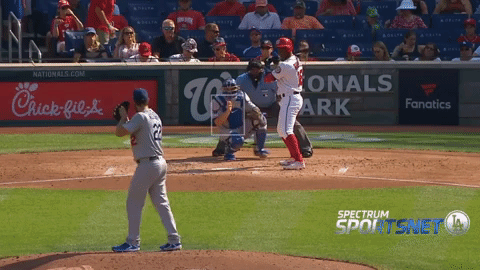
Working inside with an 0-1 count, Kershaw throws another fastball but runs this one higher, clipping the tip-top of the inside corner for ball one. That’s an incredible pitch; look at how Robles flinches. Sure, it’s a ball, but Kershaw owns the inside corner now against the young righty.
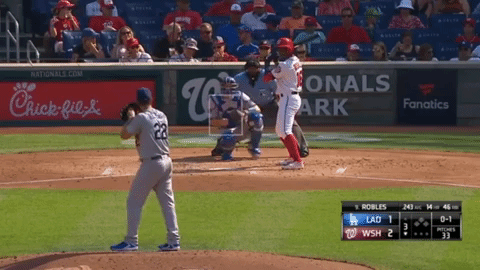
Easy peasy, kids. Kershaw works low and then high with the fastball, then drops down again for a slider. Robles unleashes quite a hack and doesn’t come close. These kinds of exchanges seem simple in the moment; down, up, down. But even if the idea is simple, the execution isn’t. Not just anyone can do this. You need great command, healthy run on the fastball and a tight, spinning slider.

Robles is in trouble. The count is 1-2. Kershaw ate his lunch with the 1-1 slider. Now what? Go back to the same pitch but drop it even lower where Robles can do nothing but foul it off or whiff. He whiffs. One down.
Kershaw dissected the young outfielder like a rat in biology class.

Next up is the speedster Trea Turner. The three-time Cy Young winner starts him with a fastball down and in for strike one.

Turner watches another fastball clip the inside corner to run the count 0-2. In David Cone‘s new book “Full Count,” he talks about the importance of being able to work on the opposite half of the plate. For Cone, that meant being able to work in on lefties; for Kershaw, as we saw with Robles and now with Turner, that means putting the fastball on the inner half. It opens up everything. Cone mentions how it’s instinctive for hitters to not want to get jammed. It hurts. That’s an arrow in the quiver for pitchers like Cone and Kershaw.

Turner has a lot of plate to cover here. To be honest, and this is by no means a dig at Turner, but he has to hope for a mistake while fending off the attacks. Sometimes hitters can mash a pitcher’s best pitch — it happens — but in an 0-2 count against a brilliant pitcher like Kershaw, it ain’t real likely. Turner might have to grind the count back to full to get a pitch to hit. It’s tough sledding.
Kershaw follows the same protocol as before, burying a slider below the plate and tempting Turner to chase. He does, but the young shortstop does just enough to dribble the ball foul. As ugly as it looks, this is a good outcome for Turner. You get another pitch. You never know.
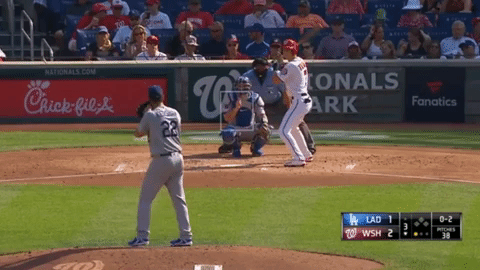
Well, sometimes that next pitch is a fastball belt high … and sometimes it’s a slider at your back foot. Two down.
(Apologies for the quick gif, by the way. The Dodgers broadcast was showing Justin Turner‘s stirrups right up until the beginning of the gif. Ugh.)
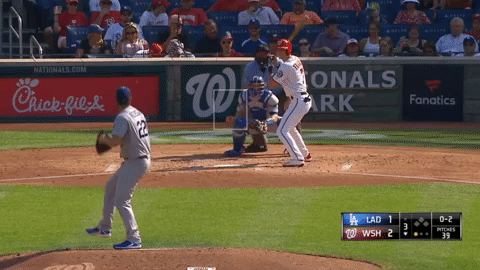
Adam Eaton steps up with two down in the third. Kershaw, facing his first lefty of the inning, again starts the at-bat with a fastball. This one, like the others, is well located and Kershaw takes control.
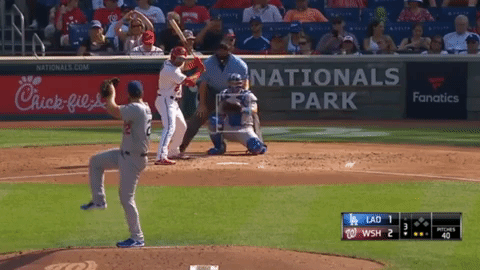
Great look at a nice slider, even if it just misses outside. I think Kershaw probably wanted it lower in the zone — working in opposite quadrants is a great way to keep hitters off balance — but again, smart pitchers work in such a way to limit potential damage. After taking a fastball near the hands for strike one, was Eaton likely to hammer this slider? Probably not.
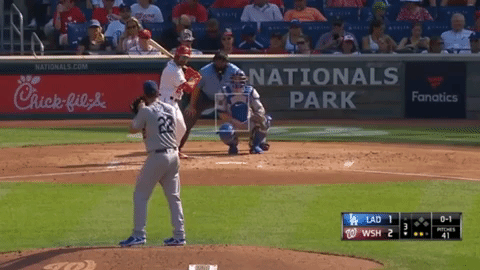
Kershaw hits the spot he likely wanted one pitch before, running a slider to the outside corner and low. Eaton reaches out and bounces it to shortstop for an easy ground out.
Smart pitching. Eaton never got anything close to a good pitch to hit. That, more than hard fastballs or biting sliders, is how you get big leaguers out consistently.
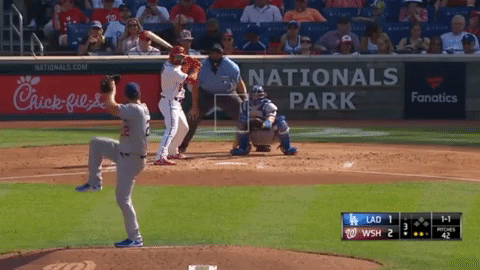
Kershaw has a lot more to give
The Dodgers are all but guaranteed to make the playoffs again. My hope is that Kershaw, often maligned for postseason scuffles, finally clicks and tears October apart. I loathe hearing great players bashed for small sample size stuff like the playoffs. Baseball is a game best understood in long stretches, and a pitcher as utterly incredible as Kershaw is bound to rip a hole through a postseason eventually.
This could be the year. Yes, he’s not throwing as hard as before, but those years of experience inform every single pitch. For one game, Kershaw can still be as good as anyone. Who wants to face Hyun-Jin Ryu, Walker Buehler and Kershaw in the playoffs this year?

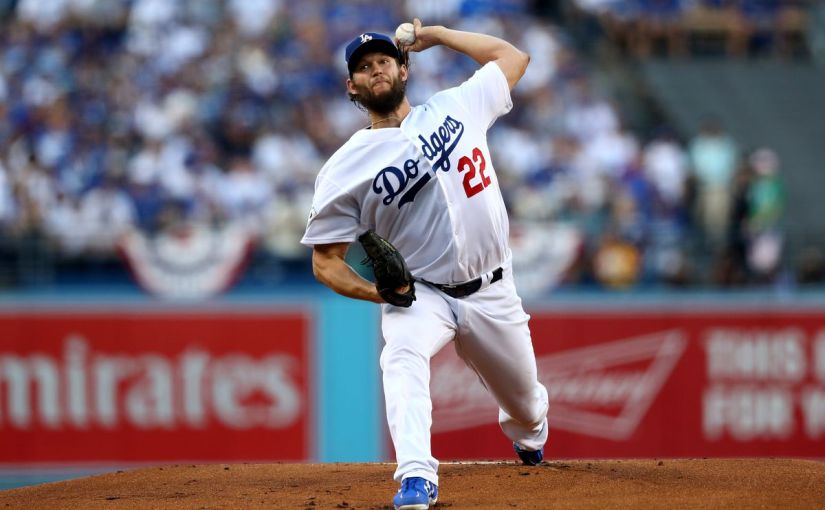
One thought on “Ode to a Pitcher: Clayton Kershaw can still twist you into knots”